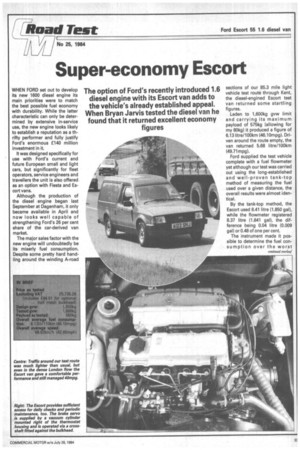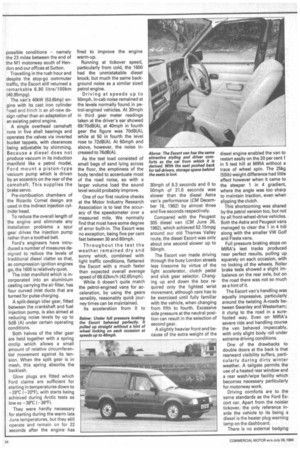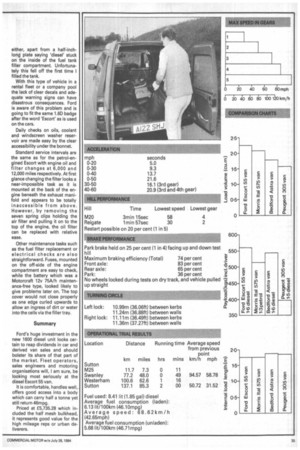Super-economy Escort
Page 35

Page 36

Page 37

If you've noticed an error in this article please click here to report it so we can fix it.
WHEN FORD set out to develop its new 1600 diesel engine its main priorities were to match the best possible fuel economy with durability. While the latter characteristic can only be determined by extensive in-service use, the new engine looks likely to establish a reputation as a thrifty performer and fully justify Ford's enormous £140 million investment in it.
It was designed specifically for use with Ford's current and future European small and light cars, but significantly for fleet operators, service engineers and travellers the unit is also offered as an option with Fiesta and Escort vans.
Although the production of the diesel engine began last September at Dagenham, it only became available in April and now looks well capable of strengthening Ford's 26 per cent share of the car-derived van market.
The major sales factor with the new engine will undoubtedly be its miserly fuel consumption. Despite some pretty hard handling around the winding A-road sections of our 85.3 mile light vehicle test route through Kent, the diesel-enginecl Escort test van returned some startling figures.
Laden to 1,600kg gvw limit and carrying its maximum payload of 575kg (allowing for my 80kg) it produced a figure of 6.13 litre/100km (46.10mpg). Driven around the route empty, the van returned 5.68 litre/100km (49.71mpg).
Ford supplied the test vehicle complete with a fuel flowmeter yet although our test was carried out using the long-established and well-proven tank-top method of measuring the fuel used over a given distance, the overall results were almost identical.
By the tank-top method, the Escort used 8.41 litre (1.850 gal), while the flowmeter registered 8.37 litre (1.841 gal), the difference being 0.04 litre (0.009 gal) or 0.48 of one per cent.
The instrument made it possible to determine the fuel consumption over the worst possible conditions — namely the 23 miles between the end of the M1 motorway south of Hendon and our offices at Sutton.
Travelling in the rush hour and despite the stop-go commuter traffic, the Escort still returned a remarkable 6.90 litre/100km (40.95mpg).
The van's 40kW (53.6bhp) engine with its cast iron cylinder ':oad and block is an all-new design rather than an adaptation of an existing petrol engine.
A single overhead camshaft runs in five shell bearings and operates the valves via inverted bucket tappets, with clearances being adjustable by shimming. Because a diesel does not produce vacuum in its induction manifold like a petrol model, Ford mount a piston-type vacuum pump which is driven by an eccentric on the rear of the camshaft. This supplies the brake servo.
Pre-combustion chambers of the Ricardo Comet design are used in the indirect injection cylinder head.
To reduce the overall length of the engine and eliminate any installation problems a spur gear drives the injection pump rather than a toothed belt.
Ford's engineers have introduced a number of measures designed to reduce the levels of traditional diesel clatter so that, as compression ignition engines go, the 1600 is relatively quiet.
The inlet manifold which is incorporated into an aluminium casting carrying the air filter, has four curved inlet ducts that are turned for pulse charging.
A split-design idler gear, fitted between the crankshaft and fuel injection pump, is also aimed at reducing noise levels by up to 5dB (A) under certain operating conditions.
Both halves of the idler gear are held together with a spring circlip which allows a small amount of relative circumferential movement against its tension. When the split gear is in mesh, this spring absorbs the backlash.
Glow plugs are fitted which Ford claims are sufficient for starting in temperatures down to —29°C (-20°F), with starts being achieved during Arctic tests as low as —38°C (-36°F).
They were hardly necessary for starting during the warm late June temperatures, but they still operate and remain on for 22 seconds after the engine has fired to improve the engine warm-up.
Running at tickover speed, particularly from cold, the 1600 had the unmistakable diesel knock, but much the same background noise as a similar sized petrol engine.
Driving at speeds up to 50mph, in-cab noise remained at the levels normally found in petrol-engined vehicles. At 30mph in third gear meter readings taken at the driver's ear showed 69/70dB(A), at 40mph in fourth gear the figure was 70dB(A), while at 50 in fourth the level rose to 72dB(A). At 60mph and above, however, the noise increased to 76dB(A).
As the test load consisted of small bags of sand lying across the floor, the emptiness of the body tended to accentuate most of the road noise, so with a larger volume load the sound level would probably improve.
One of our first routine checks at the Motor Industry Research Association is to test the accuracy of the speedometer over a measured mile. We normally find that most have some degree of error built-in. The Escort was no exception, being five per cent fast between 30 and 60mph.
Throughout the test the weather remained dry and sunny which, combined with light traffic conditions, flattered the Escort with a much faster than expected overall average speed of 68.62km/h (42.65mph).
While it doesn't quite match the petrol-engined vans for acceleration, by using the gears sensibly, reasonably quick journey times can be maintained.
Its acceleration from 0 to
30mph of 9.3 seconds and 0 to 50mph of 21.6 seconds was slower than the diesel Astra van's performance (CM December 18, 1982) by almost three and five seconds respectively.
Compared with the Peugeot 305 diesel van (CM June 26, 1982), which achieved 52.15mpg around our old Thames Valley route, the diesel Escort was only about one second slower up to 50mph.
The Escort van made driving through the busy London streets less tiresome by virtue of the light accelerator, clutch pedal and slick gear selector. Changing up and down the box required only the lightest wrist movement, although care has to be exercised until fully familiar with the vehicle, when changing from fifth to fourth. Excessive side pressure at the neutral position can result in the selection of second gear.
A slightly heavier front end because of the extra weight of the diesel engine enabled the van to restart easily on the 20 per cent 1 in 5 test hill at MIRA without a trace of wheel spin. The 25kg (551b) weight difference had little effect however when it came to the steeper 1 in 4 gradient, where the angle was too sharp to maintain traction, even when slipping the clutch.
This shortcoming was shared by the petrol version too, but not by all front-wheel-drive vehicles. Both the Astra and Peugeot vans managed to clear the 1 in 4 hill along with the smaller VW Golf and Fiesta vans.
Full pressure braking stops on MIRA's test tracks produced near perfect results, pulling up squarely on each occasion, with no locking of the wheels. Roller brake tests showed a slight imbalance on the rear axle, but on the road there was not so much as a hint of it.
The Escort van's handling was equally impressive, particularly around the twisting A-roads between Swan ley and Westerham; it clung to the road in a surefooted way. Even on MIRA's severe ride and handling course the van behaved impeccably, with only slight body roll under extreme driving conditions.
One of the drawbacks to double doors at the back is that rearward visibility suffers, particularly during dirty winter weather. A tailgate permits the use of a heated rear window and a rear wash/wipe facility which becomes necessary particularly for motorway work.
Driving comforts are to the same standards as the Ford Escort car. Apart from the noisier tickover, the only reference inside the vehicle to its being a diesel is the heater plug warning lamp on the dashboard.
There is no external badging either, apart from a half-inchlond plate saying 'diesel' stuck on the inside of the fuel tank filler compartment. Unfortunately this fell off the first time I filled the tank.
With this type of vehicle in a rental fleet or a company pool the lack of clear decals and adequate warning signs can have disastrous consequences. Ford is aware of this problem and is going to fit the same 1.6D badge after the word `Escort' as is used on the cars.
Daily checks on oils, coolant and windscreen washer reservoir are made easy by the clear accessibility under the bonnet.
Standard service intervals are the same as for the petrol-endined Escort with engine oil and filter changes at 6,000 and 12,000 miles respectively. At first glance changing the filter looks a near-impossible task as it is mounted at the back of the engine beneath the exhaust manifold and appears to be totally inaccessible from above.
However, by removing the seven spring clips holding the
air filter and pulling it on to the top of the engine, the oil filter can be replaced with relative ease.
Other maintenance tasks such as the fuel filter replacement or electrical checks are also straightforward. Fuses, mounted on the off-side of the engine compartment are easy to check, while the battery which was a Motorcraft 12v 75A/h mainten ance-free type, looked likely to give problems later on. The top cover would not close properly as one edge curled upwards to allow an ingress of dirt or water into the cells via the filler tray.
Summary Ford's huge investment in the new 1600 diesel unit looks certain to reap dividends in car and derived van sales and should bolster its share of that part of the market. Fleet operators, sales engineers and motoring organisations will, I am sure, be looking most seriously at the diesel Escort 55 van.
It is comfortable, handles well, offers good access into a body which can carry half a tonne yet still return 46mpg.
Priced at £5,735.28 which included the half mesh bulkhead, it represents good value for the high mileage reps or urban deliverers.




























































































